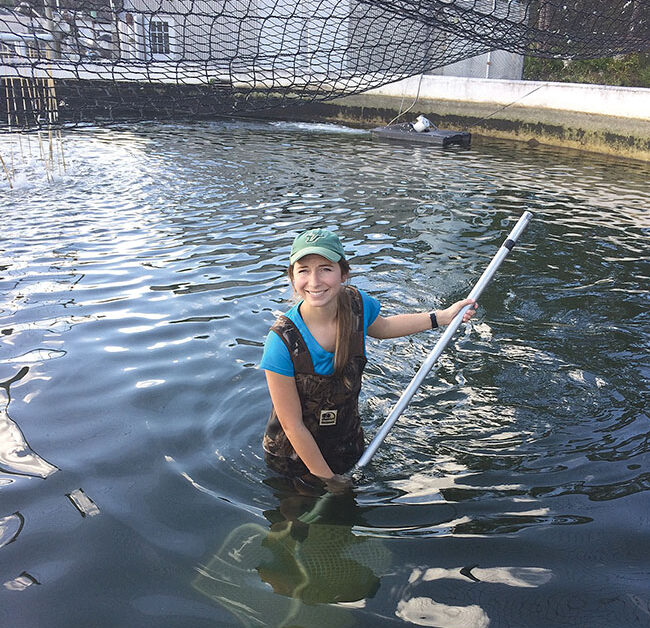
Viewpoint: One strong industry, one strong voice
January 5, 2024
By Charlie Culpepper, NAA
A federal advocacy update from the National Aquaculture Association
 NAA focuses on policy priorities that will make a real difference for American farmers.
(Photo: Evans Fish Farm, National Aquaculture Association)
NAA focuses on policy priorities that will make a real difference for American farmers.
(Photo: Evans Fish Farm, National Aquaculture Association) For over 32 years, the National Aquaculture Association (NAA) has been the unifying voice of the United States’ aquaculture sector. NAA remains committed to the growth and success of all American aquaculture farms through collaborations with state and federal governments that foster a positive business climate and cost-effective regulations that ensure environmental stewardship. As a not-for-profit trade association, we fulfill our mission primarily through federal advocacy, public outreach, and farm promotion.
With the 2023 Farm Bill on the horizon, NAA is working feverishly to communicate U.S. aquaculture priorities and get bills introduced that will make a real difference for American farmers. While the word “aquaculture” is more popular than ever in Congress, we still have an uphill battle to get current bills passed and critical priorities introduced. The following federal priorities have been carefully developed through conversations with farmers and national, regional, state and species aquaculture associations across the country and the collective expertise of NAA’s Legislative and Government Relations Committee and Board of Directors.
Waive adjusted gross income limit for ELAP
Prior to the expanded availability of USDA Farm Service Agency’s Emergency Assistance Program for Livestock, Honeybees and Farm-Raised Fish (ELAP) in May 2021, there was no catastrophic disaster assistance available for U.S. aquaculture and currently, there are no insurance options.
While we applaud U.S. Department of Agriculture (USDA)’s expansion of aquaculture eligibility, additional changes are needed to make ELAP more effective. Catastrophic loss claims are limited to 75 percent of the crop destroyed. Claims do not cover cleanup and disposal costs, and farms with an Adjusted Gross Income greater than US$900,000 are ineligible for ELAP payments.
Aquaculture is a capital-intensive farming effort with high input costs, long growing cycles, and high-value end-products. The $900,000 cap has not accounted for inflation or increases to the costs of labor, feed, equipment, and maintenance. Due to the declining value of the U.S. dollar, economic inflation and the uniquely decentralized nature of domestic aquaculture, the AGI limit severely restricts program relevance and efficacy. Waiving the AGI cap will benefit all U.S. aquaculture farms by stabilizing supply chains for small farms and giving larger farms a disaster safety net, which buoys production chains following natural disasters.
Contact your House or Senate members and ask them to co-sponsor H.R. 4127 / S. 2704 – Fair Access to Agriculture Disaster Programs Act.
Increase funding for USDA’s regional aquaculture centers
Being a successful aquaculture farmer in the United States today requires continuous adaptation to remain competitive. The five regional aquaculture centers – Northeast, South, Midwest, West and Pacific – support critical aquaculture extension and research services that are guided by and directly benefit America’s aquaculture farmers.
The centers’ work have directly advanced the science of aquaculture production, health management, genetics, nutrition, marketing and socioeconomics. A 2017 analysis reported a 37-fold return on federal investments in aquaculture research since 2000. Without any increase since 2013, the annual budget for all five centers is a mere US$5 million. The services provided by the centers are critical to support industry growth, and additional funding is critically needed.
Contact your House or Senate members and ask them to co-sponsor H.R. 3542 / S. 2619 – Promoting American Competition in Research Act.
Create an Office of Aquaculture within USDA
Aquaculture is entirely unlike terrestrial livestock and crop plant production in the huge diversity of aquatic animals and plants farmed, farming methods, farm sizes and markets. An office focused on aquaculture and an advisory committee to inform the office and agency are needed to educate agency staff across the many programs beneficial to U.S. aquaculture.
Advertisement
Contact your House or Senate members and ask them to co-sponsor H.R. 3951 / S. 2211 – Sustaining Healthy Ecosystems, Livelihoods, and Local Seafood Act!
Expand USDA services
The U.S. farming community recognizes the USDA as their lead agency. The 2020 agency-to-farming community analysis, Aquaculture is Agriculture, illuminated a variety of specific programs that would benefit aquaculture farmers given emphasis and authority.
The NAA supports these four priorities which empower USDA to better serve the aquaculture industry:
- Expand eligibility to seaweed farmers through the research, technology transfer, and economic development programs already available to terrestrial crops.
- Expand aquaculture farm eligibility within USDA programs and establish a definition of aquaculture that is inclusive of all commodity types.
- Create Organic Standards for aquaculture that allows U.S. aquaculture farmers to remain competitive with seafood imports labelled as organic under foreign standards.
- USDA Animal and Plant Health Inspection Service should regulate biotechnology for livestock, poultry and aquaculture products. The Coordinated Framework for the Regulation of Biotechnology severely limits opportunities to improve the health and welfare of animals, adapt to climate change or improve our competitiveness.
Amend the Migratory Bird Treaty Act
An Aquaculture Depredation Order existed from 1998 to 2016 under the authority of the Migratory Bird Treaty Act. It allowed the USDA Wildlife Services to work directly with fish farmers to implement non-lethal and lethal techniques to deter double-crested cormorants livestock predation.
This Order reduced an administrative burden for the U.S. Fish and Wildlife Service by eliminating permitting on a farm-by-farm basis and creating a very successful collaborative effort with USDA to mitigate economic losses.
The Migratory Bird Treaty Act, especially 16 U.S. Code § 704, should be amended to permanently invest USDA Wildlife Services with authority to issue bird depredation permits only for agricultural crops and livestock.
Update the Endangered Species Act
The Endangered Species Act inadvertently prevents the opportunity for U.S. aquaculture farmers to contribute husbandry expertise to help restore at-risk wild populations and benefit from a captive-bred exemption allowed under the Convention on International Trade in Endangered Species of Wild Fauna and Flora (CITES).
A captive-bred exemption should be created for listed species, and within ESA Section 4(d), recognize farmer and rancher animal services that assist state and federal agencies in the recovery of listed or at-risk species through public or private captive breeding directed towards population recovery.
Oppose presumptive prohibitions on Nonnative Species Trade
Injurious wildlife risk management is most effectively accomplished through Tribal and state governments. As non-native species simply do not pose equal risks across the nation’s various eco-regions or under different captivity conditions, we oppose efforts to amend the Lacey Act which attempt to empower the Secretary of the Interior to list species under Emergency Rule without due process or prohibit the interstate movement of Injurious Wildlife within the continental United States.
The nation’s capability to assess and respond to non-native risks could be improved by providing funding to state and local governments to improve regional risk management capabilities, classifying accidental violations as minor misdemeanors, and publicly posting real-time federal, state, and tribal regulations for non-native species.
U.S. aquaculture farmers, in all their great diversity, share far more commonalities than differences, especially at the federal level. Complex, costly, duplicative, and onerous regulations present the single most substantial barrier to the success of American aquaculture in all its forms.
Farmers, suppliers, academic and government staff, and students must unite to create “one strong industry, one strong voice” that moves the needle for all of U.S. aquaculture. For 32 years, a group of proud farmers has been fighting to achieve this goal, and today more than ever, the National Aquaculture Association needs your support in D.C.
 Charlie Culpepper, NAA director of membership and public outreach (charlie@nationalaquaculture.org)
Charlie Culpepper, NAA director of membership and public outreach (charlie@nationalaquaculture.org)
- Cooke Aquaculture veterans recognized with lifetime achievement awards
- New oyster farm approved in Nova Scotia





